Why you should grow and keep big muscles
Life isn’t just about how long we live; it’s about how well we live it. We often hear about increasing our lifespan, but is a longer life worth it if we can’t move and become dependent on others? What’s equally, or even more important, is enhancing our healthspan—the period during which we enjoy a good quality of life. From what I’ve observed when talking to older people, they care more about “improving the quality of their life” than “living a longer life”
Imagine being unable to engage in activities you love, like traveling, playing with kids, hiking, or even just gardening. The loss of functional ability can lead to a diminished the enjoyment we have in life.
What can you do to maintain your independence, relationships, and dignity? I believe the answer lies in working out, especially resistance training that helps keeping our strength. In his book “Outlive”, Peter Attia shows how we can increase our healthpan and combat the effect of aging :
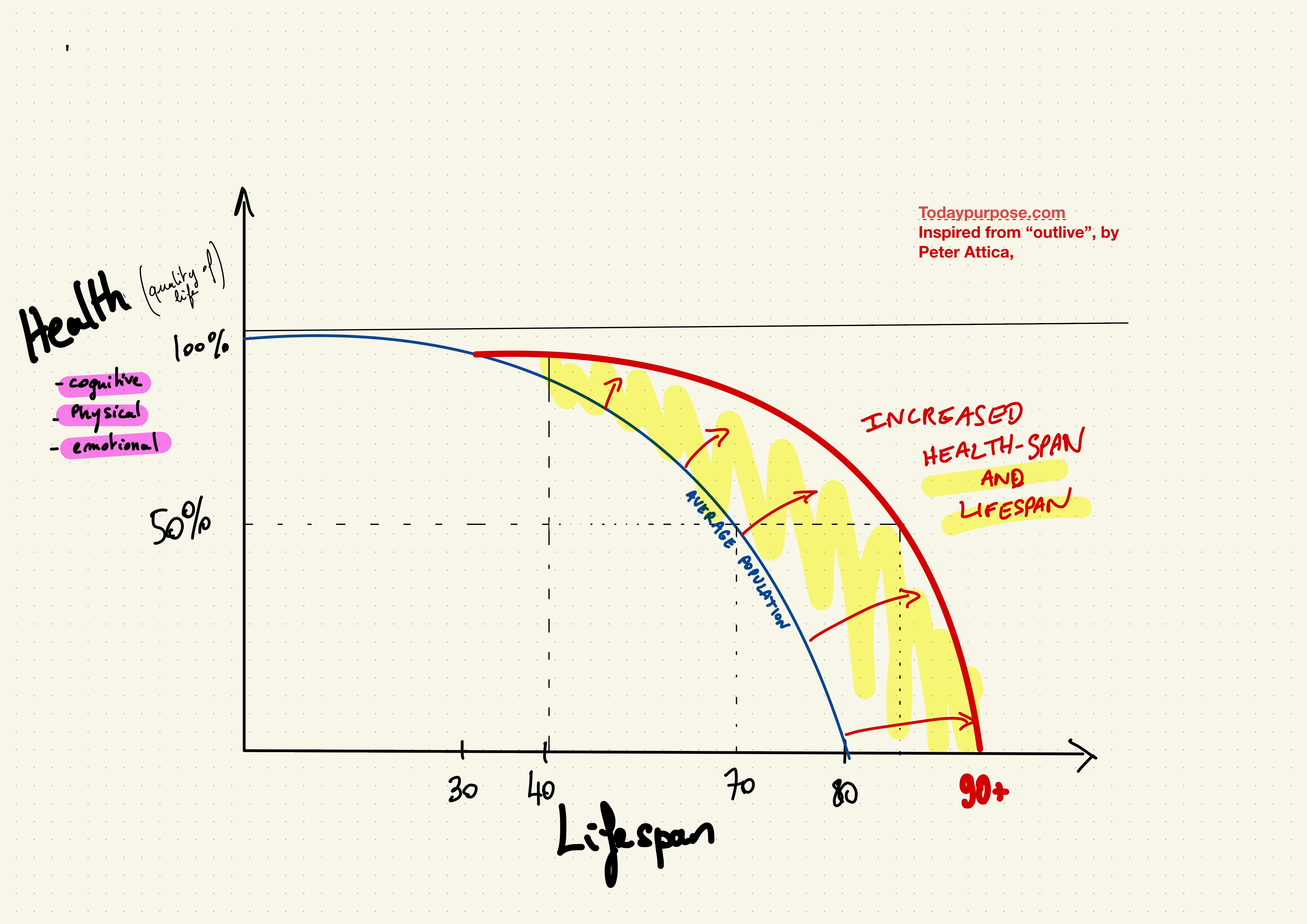
“Exercise is by far the most potent longevity ‘drug’ available.” It’s not just about delaying death; it’s about preserving cognitive and physical abilities.
The inevitable decline begins in your 30s
Many of us don’t notice it in our 20s, but as we enter our 30s, the signs become more and more reccurent. Recovery from injuries slows down, we get tired more quickly, and our overall vigor starts to wane.
sarcopenia: losing muscle and strength as we age
Sarcopenia is the loss of muscle strength with age. It often catches people off guard and people realize it when it’s too late. Starting as early as age 30, we begin to lose 3% to 5% of our muscle mass each decade. By the end of a typical lifespan, most individuals have lost about 30% of their muscle strength. Preserving muscle mass is crucial. No amount of cardio (running, cycling) can combat this natural decline. Both men and women need to engage in strength training along with cardiovascular exercise.
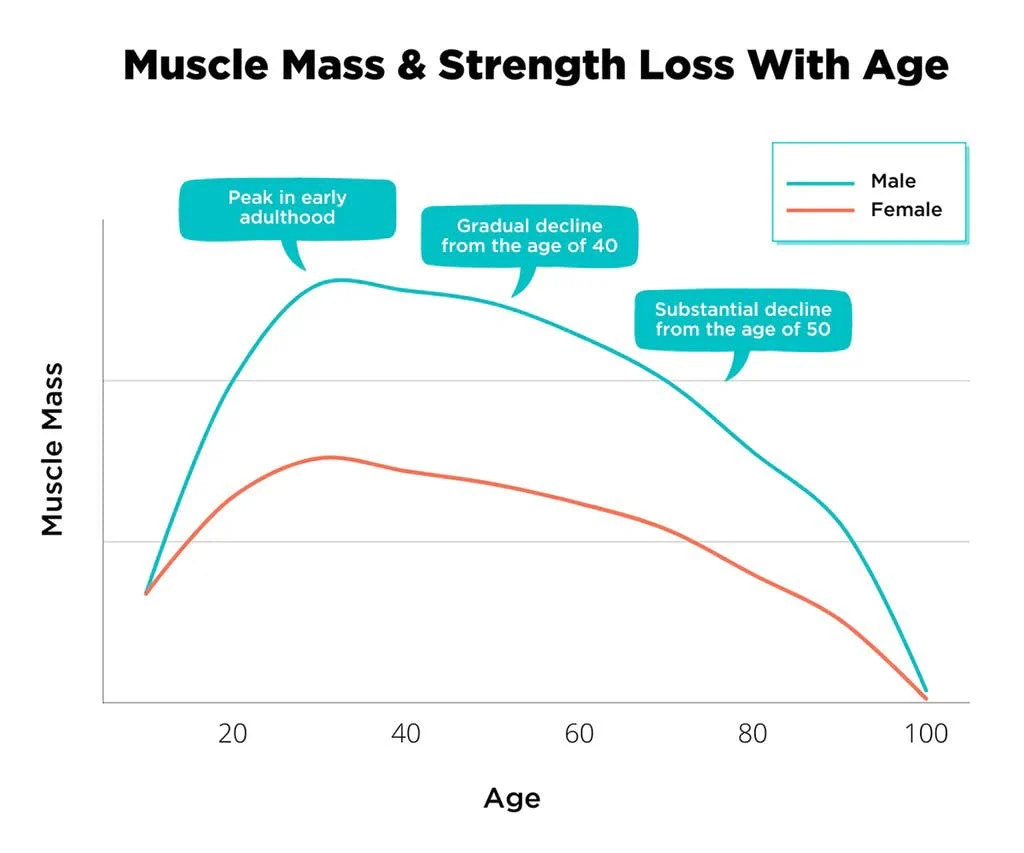
Look at the similarities in thigh muscle of the triathletes and someone who does not move below (source):
Resistance Training: The ultimate drug to improve healthspan
The graph show than our peak strength happen at 30 and start decreasing over time:
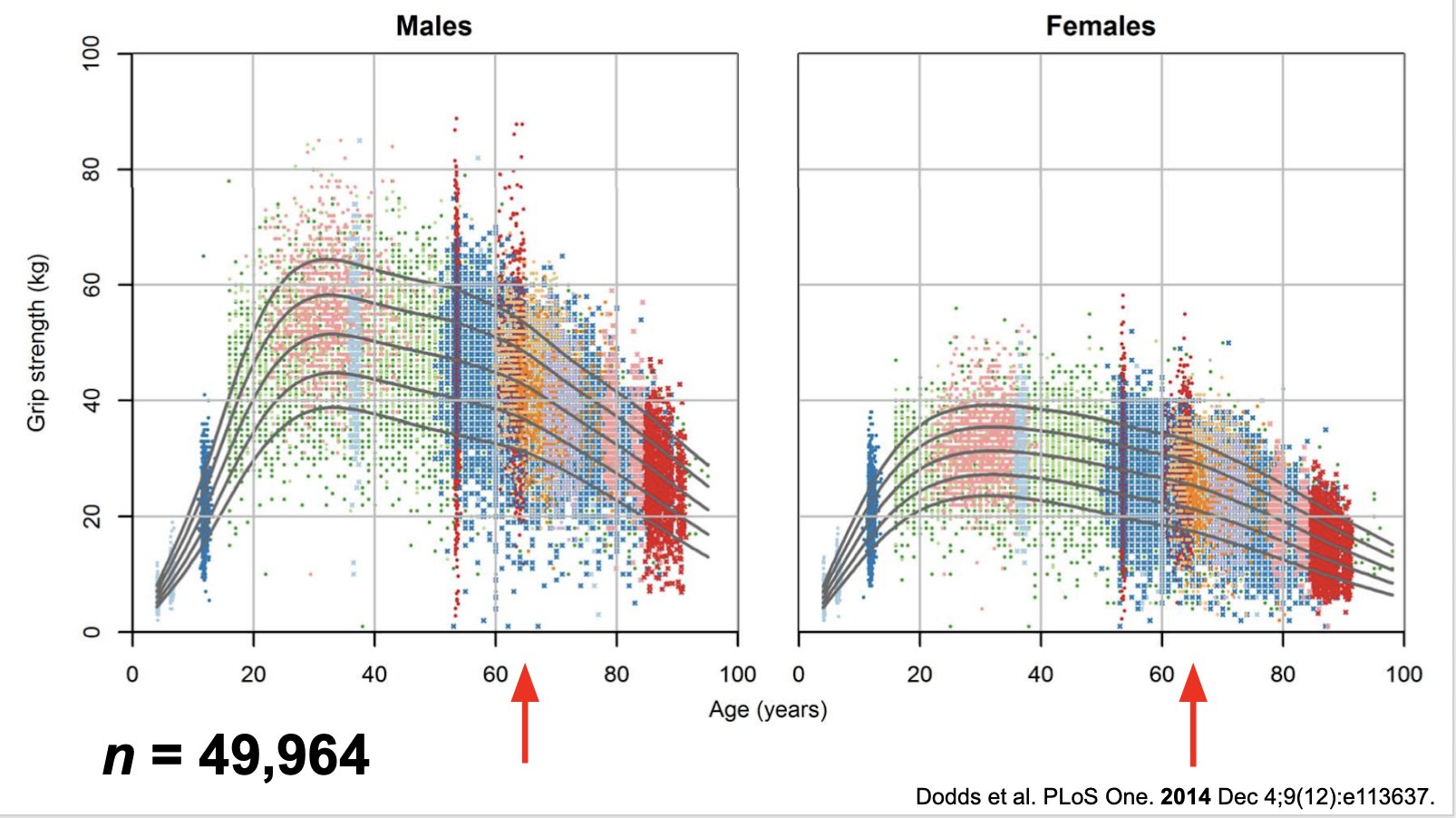
This other graph show the effect of resistance training, and how it can prevent disability:
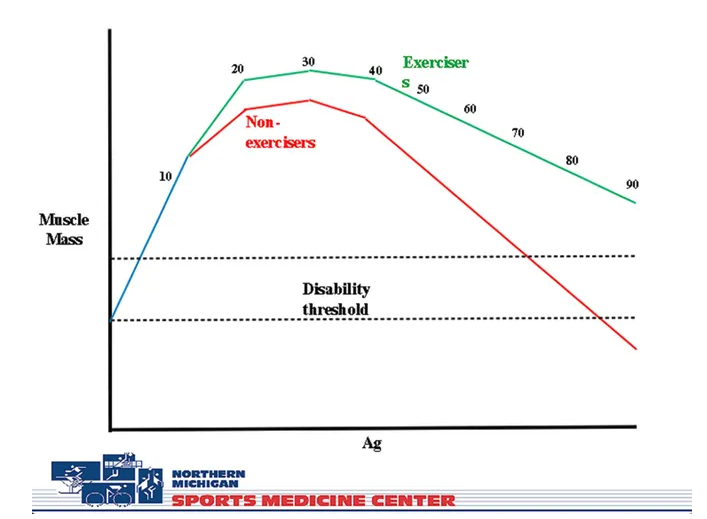
Without resistance training, our bodies undergo a transformation post-30: muscle loss gives way to a higher fat percentage, leading to a weaker physique and the lose of autonomy.
reducing the risk of injuries and falls
Falls are a leading cause of mortality for people over 75. Resistance training enhances lower body strength, crucial for activities like climbing stairs or simply standing up from a chair. Stronger muscles also mean better balance and a reduced risk of falls, which can be catastrophic in later life. Starting 60-65: risk of falls that lead to immediate death or within 12 months (break hips / femur) is really high (15-30% depending the study). Over 14 million, or 1 in 4 older adults report falling every year. It is also the leading cause on the non-fatal injuries in the USA at all ages :

a 20-year advantage
Research shows that 85-year-old individuals who have consistently engaged in weightlifting display similar physical power to non-lifting 65-year-olds. Long-term resistance training can grant an approximate 20-year advantage in physical capabilities.
avoiding pains
If you are in your 30s like me, you probably already feel it. Regular exercise, especially strength training, plays a vital role in pain prevention and management. Weak muscles and a sedentary lifestyle often lead to chronic pain issues, which can severely impact the quality of life in our later years.
Other reasons to stay strong as we age?
cognitive benefits, mood, stamina
Resistance training doesn’t just benefit the body; it also supports cognitive health. Low muscle mass and physical inactivity are linked to cognitive decline in old age. Exercise releases myokines, which support brain health, indicating a dose-dependent effect between muscle mass and cognitive function.
It also boost mood and reduce symptoms of anxiety and depression. When pushing hard, your body release endorphins and other mood-enhancing chemicals during exercise. These natural mood lifters contribute to a sense of well-being you can get each time you go for a workout.
Beyond building muscle strength, resistance training enhances overall stamina and endurance. This increased stamina is not just physical; it translates into greater mental and emotional resilience. Older adults with higher levels of fitness and stamina are better equipped to handle the challenges of daily life, remain independent, and engage in social activities, which are crucial for mental health and quality of life.
being in control
Resistance training is the art of pushing yourself than what you think is your limit. It teaches the value of persistence, discipline, and hard work. The satisfaction of achieving a physical goal through resistance training, and in my humble opinion, can boost confidence in one’s ability to overcome other challenges in life you might think are not possible to overcome.
Alan Thrall (that I started following because his excellent “how to squat video”) puts it really well. Why did he kept working out during a crazy time such has the first weeks of having a baby and he his overwhelmed?
When times get tough, I need keeps everyone (his household) grounded, and helps people moving to the right direction. Stay 1 step ahead of everything, and not only being pushed around by life circumstances. I need to be stronger than the situation.
independance, autonomy
As we lost strength we will lose ability to grab things, or even walk. This might lead to Keeping some dignity as a human being. The ability to engage in activities like playing with kids, hiking, or traveling is not just a matter of physical capability; it’s also about maintaining independence and relationships, which are central to happiness. As we age, the desire to remain self-reliant grows stronger, and resistance training plays a crucial role in this.
keeping relationships
Strength directly influences our ability to maintain social connections. If our mobility decreases, so does the ability to visit friends and family, which can lead to isolation and loneliness.
Staying strong and mobile enables us to actively participate in social activities, maintaining and nurturing relationships that are essential for mental and emotional well-being.
Staying healthy is probably the best gift we can give to our children. As we become more dependent due to health issues, we not only incur significant healthcare costs but also potentially place a financial and emotional burden on our families.
reducing risk of cancer and heart disease:
Resistance training can lead from 10 to 20 percent reduction in the risk of early death from all causes, including cancer and heart disease: https://bjsm.bmj.com/content/56/13/755
staying fit by doing “nothing”
Friends usually ask me how I can stay fit by eating that much I believe I have and advantage I’ve been building since I was 10ish: I kept working out. I’ve built muscle over the years, and my resting metabolic rate . Lean muscle burns more calories than fat, even at rest. Having more muscle is a kind of cheat code. By increasing muscle mass your resting metabolic rate goes up. It means that you can burn more calories when you are at rest:
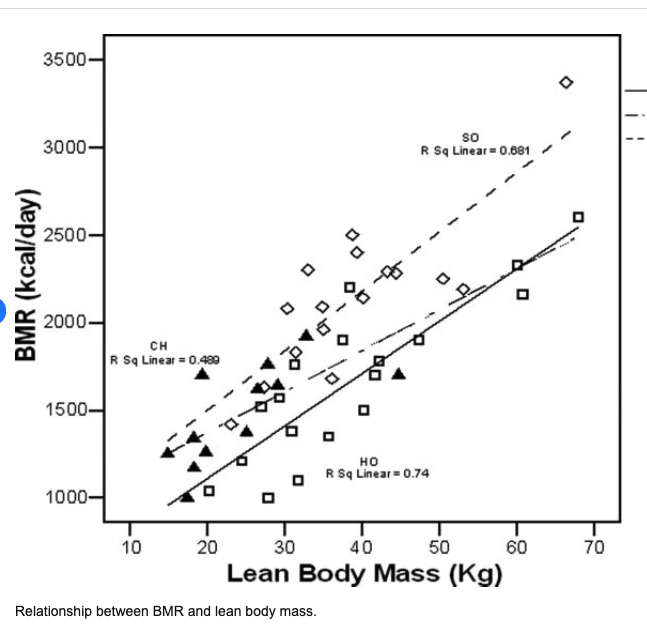
Of course you’ll need to preserve those muscle with resistance training.
Some last words
Resistance training is a choice you make. It’s hard, but only has upsides for your current and future self. It is never too late to start. The benefits of starting it can be seen at any age. The key is to keep doing it, no matter what.
My only advices:
- Find good lasting reasons to workout (I hope this article helped) and stop finding excuses to not go.
- If you’re over 30 (or even in your 20s and able to afford it), hire a personal trainer to start. They can check your form and avoid any kind of injuries. With weights, it is really easy to get a bad form, no matter how many youtube videos you watch. I went to see a Physiotherapist 4 years after I started squats, and this is the best thing I’ve ever done. She retaught me everything I think I knew about squatting.
- I also do a bit of aerobic exercices: running 1 hour a week and playing volleyball once a week. But excessive cardio is counterproductive, leading to loss of muscle mass and potential joint issues.
- The CDC recommends 2+ days per week that work all major muscle groups (legs, hips, back, abdomen, chest, shoulders, and arms).
- For very beginner, I do recommend the 5x5 program. The program work on all biggest muscles of your body. I do also like their app that is really easy to follow. There is plenty of strength training gurus out there. No matter what program you pick, you’ll find benefits any of them.
- When you go to the gym, leave your ego at home, and never compare yourself to others. You’ll just get injured.
Liked this post ? You’ll love that one: On Time, Money and Health
